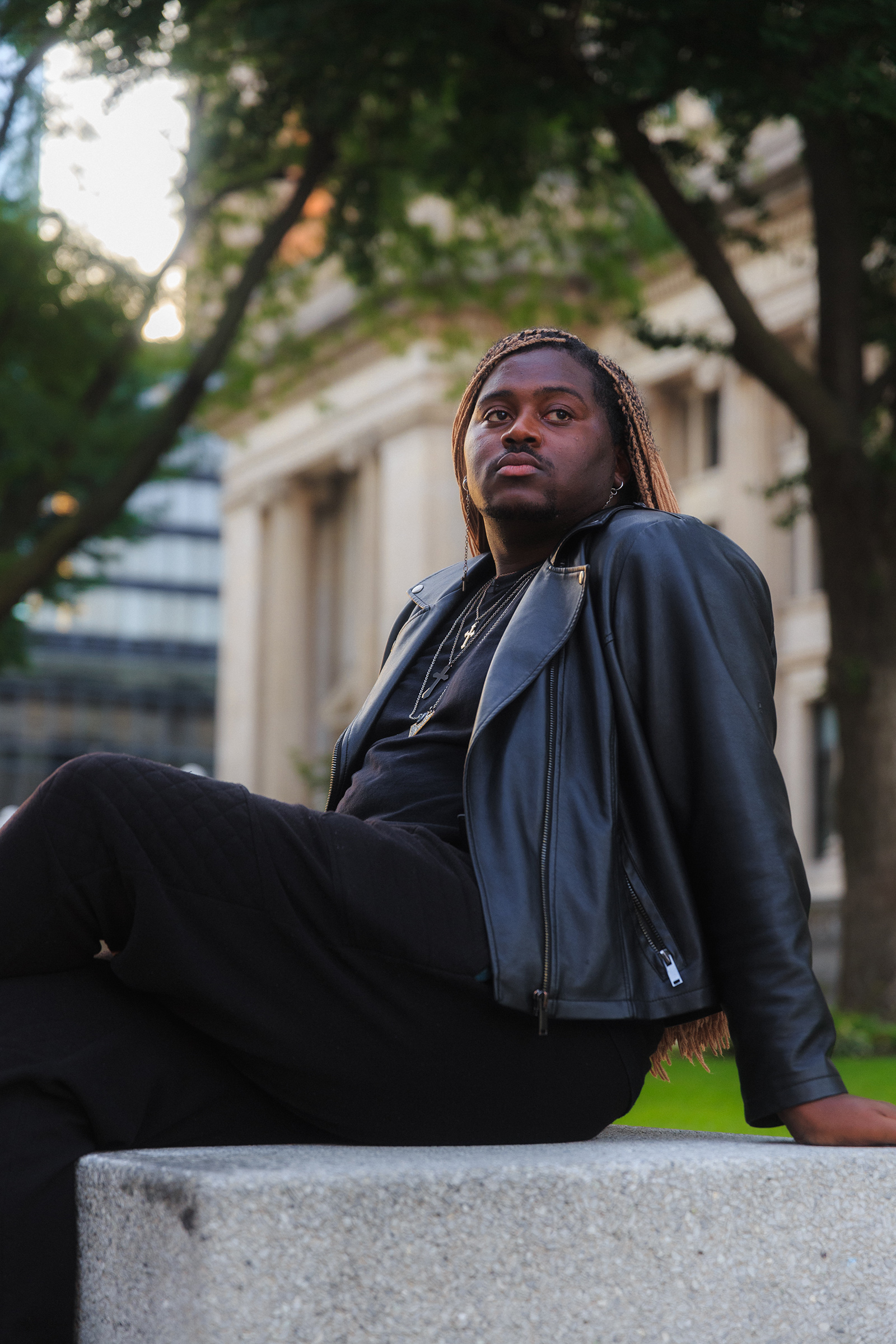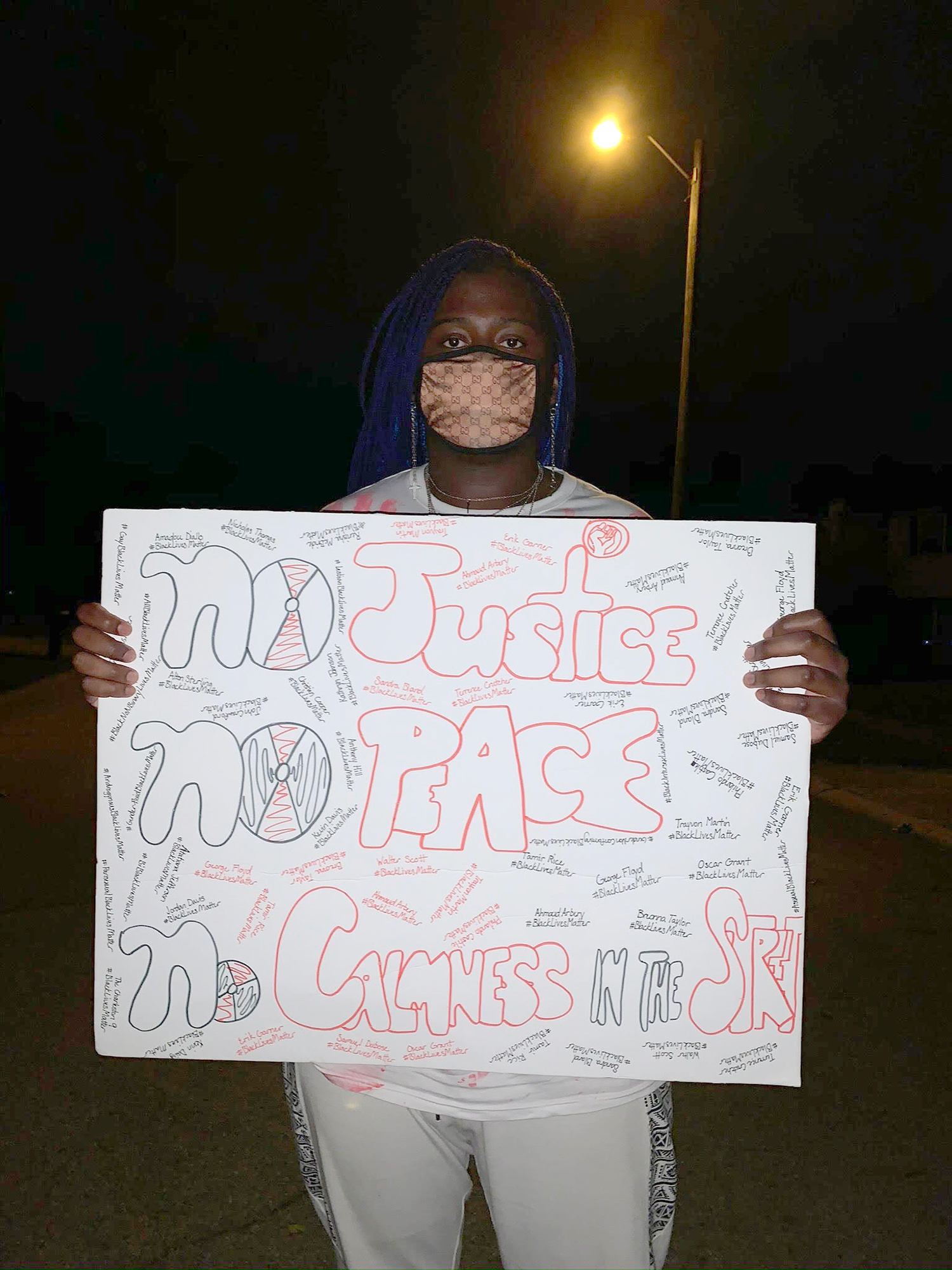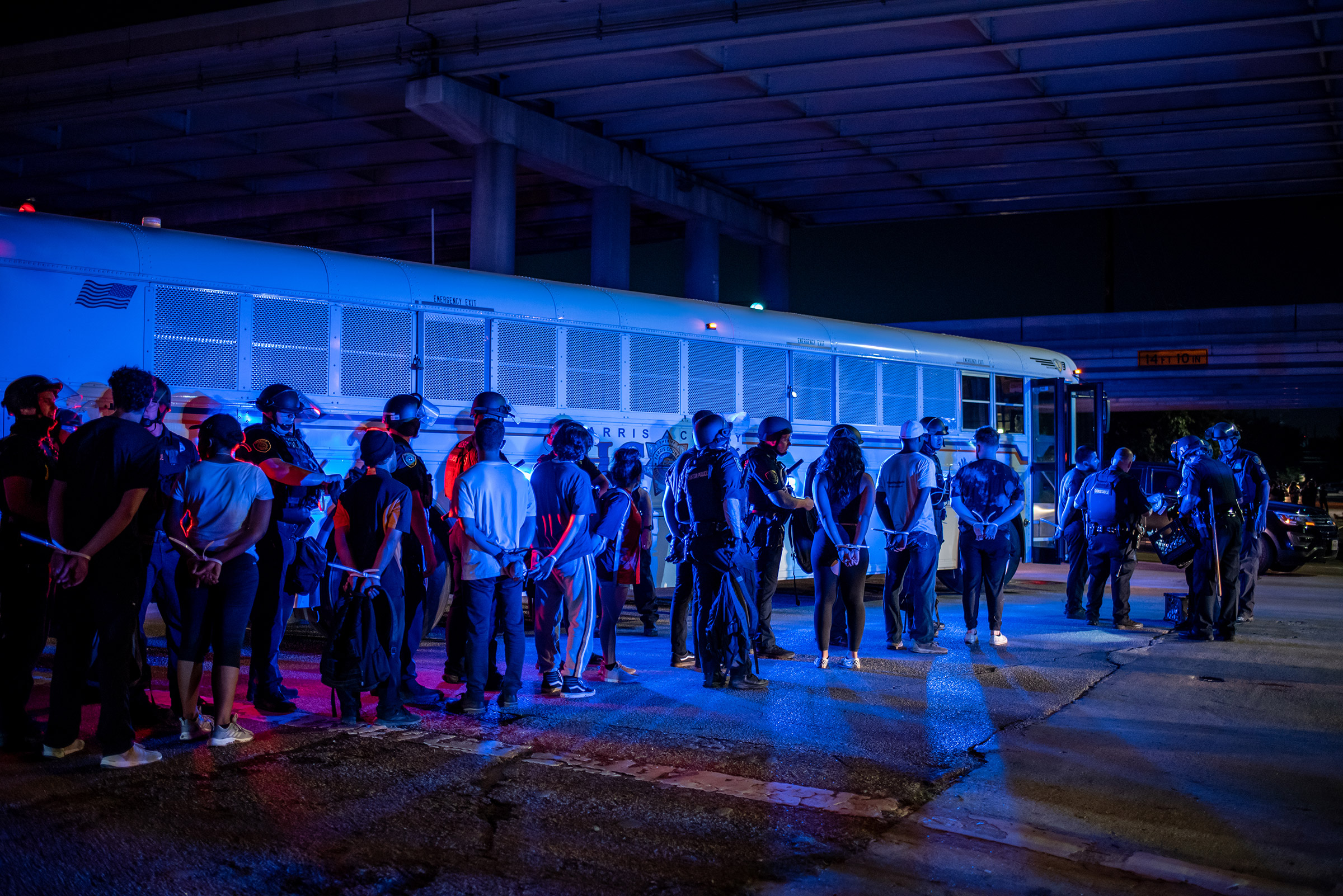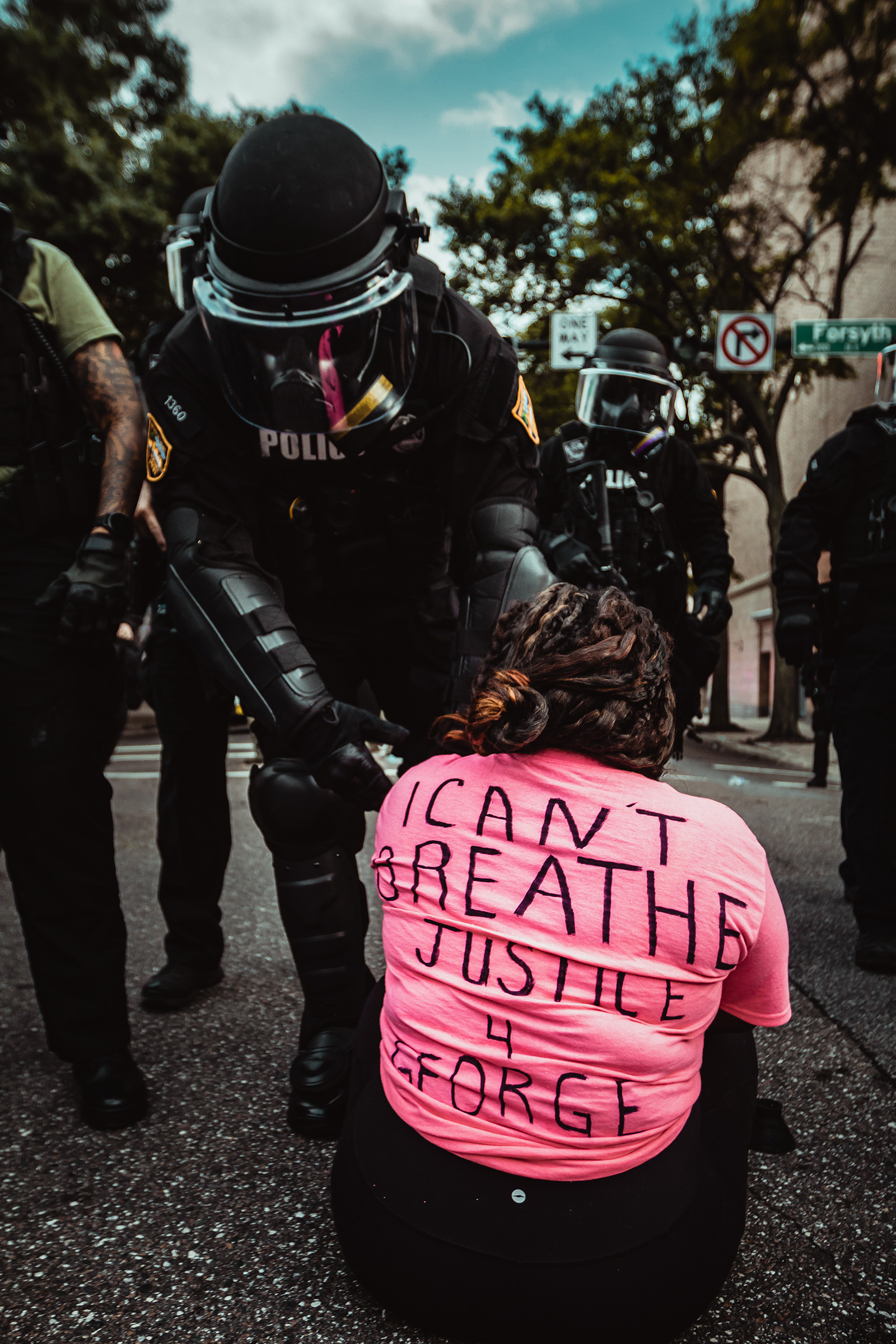
D’Angelo Sandidge was lying in bed and scrolling through Instagram on June 1, thinking about the ground sausage he was about to fry for breakfast, when he stumbled upon a video that he’d heard about but not yet seen. His anger intensified as he watched the footage of George Floyd begging for his life while a white Minneapolis police officer knelt on his neck. By the time the video ended, after he’d watched Floyd, who was Black, call out for his mother and eventually fall silent, Sandidge had lost his appetite. “I felt sick to my stomach,” he says.
Until that moment, Sandidge, who is also Black, had not been one to hit the streets in protests, but this was different. At 6 ft. 4 in. tall and 280 lb., he is about the same height as Floyd and substantially heavier, and that video was a reminder of how quick people are to judge those who look like him. So the next day, Sandidge bought a poster board and some markers and made a sign wider and taller than his torso that read, “no justice, no peace, no calmness in the street.”
Sparked by a sense of urgency to take a stand as a Black man in America and by a desire to find camaraderie among people who can relate to his pain, the 24-year-old set out to join a Black Lives Matter protest in downtown Indianapolis.

By the end of the night, he was in jail, accused of violating curfew and resisting arrest by fleeing. Police say that as he fled, Sandidge was trying to reach into his backpack, where they found a taser and a can of bear spray—items Sandidge says he normally carries for self-protection. He was not charged with the curfew violation, but Sandidge faces up to a year in prison and a fine of up to $5,000 if convicted of resisting arrest. Worse for Sandidge, even though it’s a misdemeanor, the charge will show up on background checks even if he’s acquitted or the case is dismissed.
“I’ve never dealt with anything like this,” says Sandidge, who didn’t have a smudge on his driving record, much less a criminal history, when he was arrested. “I don’t know what I’m going to do now.”
***
Demonstrations against racism and police violence led to more than 7,600 arrests in the U.S. in May and June, according to the Crowd Counting Consortium, which collects data from news reports. An Associated Press tally found more than 10,000 protesters were arrested in just the first 10 days after Floyd’s death on May 25. Amid the ongoing protests, many of those jailed, however briefly, are coming to terms with the repercussions of their decisions to take part in a major moment in history. Young protesters, particularly those of color, face chilling consequences on top of prosecution, including costly fines, loss of employment and a stigma that legal experts say could affect their ability to obtain housing, jobs, education and occupational licenses. “My confidence and my faith that I’ll get everything back on track is shattered,” Sandidge says.
In what experts call the largest sustained mobilization in modern history, some 23 million people across the U.S. have attended demonstrations since Floyd’s death, a Civis poll from mid-June suggests. According to a national Pew Research survey of more than 600 people who say they attended a recent protest focused on race, about 41% were younger than 30. Of those 600, 17% were Black, 22% were Hispanic, and 46% were white. A smaller survey looking at protest demographics in Washington, D.C., New York City and Los Angeles found that the median age of protesters was 29, according to Dana Fisher, a University of Maryland sociology professor whose team conducted surveys in the three cities in June. About 25% of those polled were 24 or younger, Fisher says, and white protesters made up about 54% of the crowds.
But when it came to arrests, the faces were less diverse. While there is no racial breakdown of protest arrests nationwide, some analyses of city and county arrest records the first weekend after Floyd’s death show that many who were jailed were Black. Of the 2,172 people the Chicago police department arrested from May 29 to May 31, more than 70% were Black and 10% were white, according to an analysis of police department records by the Chicago Reader. In Atlanta, 48 of the 82 people processed through the Fulton County jail that same weekend were Black, Georgia Public Broadcasting found.

When Sandidge was sitting on the sidewalk in handcuffs, he says, white bystanders walked past him without being stopped by police, even though they were also out after the 9 p.m. curfew. At one point in the night, he says, all 25 inmates in his jail cell were Black. He often wonders why authorities stopped him in the first place. Each time, he comes to the same conclusion. “One hundred percent it was because I was Black,” he says. The Indianapolis Metropolitan police declined to comment.
Coricia Campbell, a Marine veteran who is Black, also believes race played a role in her arrest. On May 30, during a demonstration in Jacksonville, Fla., Campbell was sitting on the ground beside a white friend who was also protesting. Video shows police officers shoving Campbell’s friend aside while pulling Campbell into their midst and handcuffing her. “In that entire line of people, I was the only one who was arrested,” she says. In her holding cell, one woman out of eight was white, Campbell adds. “It’s really hard not to think it was racial profiling,” she says.
Orlando criminal-defense lawyer James Smith says the racial disparity in protest arrests is not surprising. Black Americans in general are more likely than white Americans to be arrested, convicted and given lengthy prison sentences, according to a 2018 report by the Sentencing Project, a nonprofit focused on reforming the U.S. criminal-justice system. There are many reasons for the disparity, the report found, including racial biases at every level of the justice system, including among police officers, prosecutors, judges, jurors and parole boards. Black and Hispanic defendants are more likely than white defendants to be denied bail, according to the report, and they’re more likely to accept plea deals—even if they protest their innocence—because they’re less likely to be able to afford costly legal battles.

The recent round of arrests “highlights the racial double standard here in this nation,” says Smith, who represents seven arrested protesters, all of them Black or Hispanic.
The disparities go beyond arrests. When it comes to employment, an arrest or conviction can decrease the likelihood of getting a callback for jobs, especially if an applicant is a person of color, says Beth Avery, a senior staff attorney with the National Employment Law Project (NELP). That means Black and Hispanic protesters will be most affected in the long term if they’re arrested at demonstrations. “These protests going on all around the country are all about racial inequities and bias in our criminal legal system, and it doesn’t stop with the police,” Avery says. “It permeates throughout all these other aspects of life.”
If a young protester who was recently arrested applies for a job now or for student loans, their pending criminal case will likely pop up. Criminal-history questions also appear in the majority of undergraduate college applications. National surveys have shown that 60% to 80% of private institutions and 55% of public institutions require prospective students to answer questions about their criminal past during the admission process, according to a Brookings Institution report.
“One thing I don’t think the average American realizes is just how devastating even an initial contact with the criminal-justice system can be,” Smith says. “The perfect storm is for that college-aged student who is trying to get their lives started.”
Even for someone like Campbell, who is 31 and has a job, the results of her arrest have been devastating. Prosecutors dropped Campbell’s unlawful-assembly charge, but while she was in jail, Campbell missed a surgery scheduled to remove her gallbladder. “It’s a really stressful situation,” says Campbell, who suffers from irritable bowel syndrome and gastroesophageal reflux disease. Because of COVID-19, she doesn’t know when she can reschedule the operation.
But Campbell says she felt a duty to protest and doesn’t regret her decision. In fact, she’s participated in three more demonstrations since her arrest. “Regret implies that if you had a choice to do it over again, you’d make a different decision,” says Campbell. “I would still be there.”

Lawyers representing protesters fear many are marching under the mistaken impression that minor cases disappear rom criminal records once charges are cleared. Sandidge and Campbell walked into protests with that mindset.
But in reality, arrests remain on criminal records in most states’ court systems, threatening a person’s ability to find work and housing for years. At least 28 states, including where Sandidge and Campbell were arrested, require an individual to take often onerous court actions to seal or expunge an arrest record, even if they’ve been acquitted or a charge has been dismissed, according to the nonprofit Collateral Consequences Resource Center. Even then, many states allow only one expungement in a lifetime, says John Phillips, a Florida civil rights lawyer who helped get Campbell’s unlawful-assembly charge dismissed.
“Right now, you think you’re invincible,” Phillips says. “But this may stick, and it can add up. It’s a snowball going down the mountain.”
Records of arrests and even mug shots also live on in public and private databases, which employers, college-admissions boards and some loan issuers can access. “All someone has to do is Google your name, and information will come up showing what you’re arrested for,” Smith says. “The arrest record could frankly be around for most of your productive life.”
This has long been a problem in a nation where nearly one in three adults, or 70 million, have an arrest or conviction record and where, according to the Brennan Center for Justice, as many Americans have criminal records as college diplomas. “Employers are not supposed to rely on arrest records alone,” says Avery, the NELP attorney. “But the truth is that if it shows up on a background check, it’s going to affect an employer’s view of the applicant.”
A movement to prevent this has made progress. Thirty-five states since 1998 have adopted so-called Ban the Box laws or policies that require public-sector employers to consider job candidates’ qualifications before asking them to disclose arrest or conviction records. Fourteen of those states have gone further, prohibiting private employers from including questions about criminal convictions on job applications.
“We’re coming around to everyone recognizing that perhaps people with an arrest or conviction record shouldn’t be perpetually punished,” Avery says. But the change may not be happening quickly enough to save today’s protesters from years of setbacks.
***
On the afternoon of June 2, Sandidge took his homemade sign and joined dozens of demonstrators at the Soldiers and Sailors Monument in downtown Indianapolis. He left for a while, then decided to return with a friend at about 10 p.m. As he got near the rally after parking his car, Sandidge says, he heard shouts and saw figures charging toward him in the dark. He says he ran, not knowing the figures were police.
According to a probable-cause affidavit obtained by TIME, police said they spotted Sandidge and another man trying to duck behind flower beds. The men began running as one officer shouted “Stop. Police,” sparking a foot chase that ended with the two being captured and handcuffed.
The county prosecutor cleared more than 100 people arrested that first weekend in June for nonviolent offenses. But because police allege Sandidge had been trying to reach into his bag before he was apprehended, possibly for a weapon, a spokesman for the prosecutor’s office told TIME his charge was warranted. He declined to comment further on the case.
Sandidge denies trying to get into his bag and says he had no intention of using anything inside it as a weapon. The spray was sealed, and the taser was in a secured pouch, says Sandidge. Indiana law permits the carrying of both without a permit.
“For me to be another statistic, it terrifies me,” Sandidge says of his arrest record. “I’ve never, never, never had to worry about having anxiety or fear because I’ve always had a clean track record.”
After a little over 24 hours in jail, Sandidge was released a few hours before he was due to attend an orientation for a job at a security company. Because he was concerned about being exposed in jail to COVID-19 and because his wallet, which had his driver’s license, had been confiscated and not yet returned, Sandidge missed the orientation. The company offered him the option of completing his orientation online, but Sandidge says he was too preoccupied and felt his life was too much “in shambles” to continue pursuing the job.
“I wouldn’t have been any good to anyone in a work environment,” he says.
Sandidge’s first court appearance is scheduled for Sept. 16. Until then, all he can do is wait. If he applies for a job now, his pending criminal case may hinder his chances. He’s filled with fear thinking about the outcome of his case, about his next possible encounter with police and about whether he has sabotaged his future, derailing his plan of saving enough money for college. “It did something different to me,” he says of his arrest. “It changed me.”
More Must-Reads from TIME
- How Donald Trump Won
- The Best Inventions of 2024
- Why Sleep Is the Key to Living Longer
- Robert Zemeckis Just Wants to Move You
- How to Break 8 Toxic Communication Habits
- Nicola Coughlan Bet on Herself—And Won
- Why Vinegar Is So Good for You
- Meet TIME's Newest Class of Next Generation Leaders
Contact us at letters@time.com